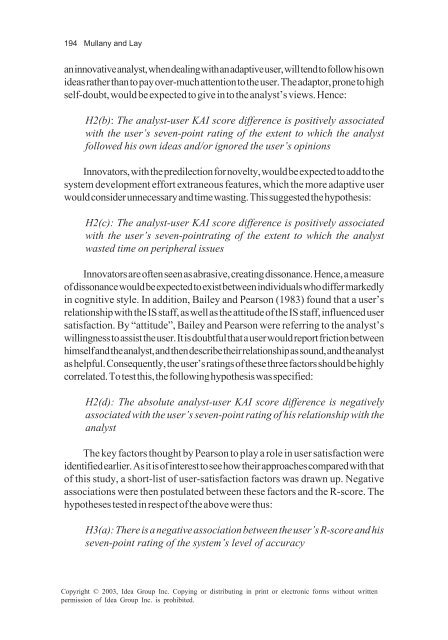www.sharexxx.net - free books & magazines
www.sharexxx.net - free books & magazines
www.sharexxx.net - free books & magazines
You also want an ePaper? Increase the reach of your titles
YUMPU automatically turns print PDFs into web optimized ePapers that Google loves.
194 Mullany and Lay<br />
an innovative analyst, when dealing with an adaptive user, will tend to follow his own<br />
ideas rather than to pay over-much attention to the user. The adaptor, prone to high<br />
self-doubt, would be expected to give in to the analyst’s views. Hence:<br />
H2(b): The analyst-user KAI score difference is positively associated<br />
with the user’s seven-point rating of the extent to which the analyst<br />
followed his own ideas and/or ignored the user’s opinions<br />
Innovators, with the predilection for novelty, would be expected to add to the<br />
system development effort extraneous features, which the more adaptive user<br />
would consider unnecessary and time wasting. This suggested the hypothesis:<br />
H2(c): The analyst-user KAI score difference is positively associated<br />
with the user’s seven-pointrating of the extent to which the analyst<br />
wasted time on peripheral issues<br />
Innovators are often seen as abrasive, creating dissonance. Hence, a measure<br />
of dissonance would be expected to exist between individuals who differ markedly<br />
in cognitive style. In addition, Bailey and Pearson (1983) found that a user’s<br />
relationship with the IS staff, as well as the attitude of the IS staff, influenced user<br />
satisfaction. By “attitude”, Bailey and Pearson were referring to the analyst’s<br />
willingness to assist the user. It is doubtful that a user would report friction between<br />
himself and the analyst, and then describe their relationship as sound, and the analyst<br />
as helpful. Consequently, the user’s ratings of these three factors should be highly<br />
correlated. To test this, the following hypothesis was specified:<br />
H2(d): The absolute analyst-user KAI score difference is negatively<br />
associated with the user’s seven-point rating of his relationship with the<br />
analyst<br />
The key factors thought by Pearson to play a role in user satisfaction were<br />
identified earlier. As it is of interest to see how their approaches compared with that<br />
of this study, a short-list of user-satisfaction factors was drawn up. Negative<br />
associations were then postulated between these factors and the R-score. The<br />
hypotheses tested in respect of the above were thus:<br />
H3(a): There is a negative association between the user’s R-score and his<br />
seven-point rating of the system’s level of accuracy<br />
Copyright © 2003, Idea Group Inc. Copying or distributing in print or electronic forms without written<br />
permission of Idea Group Inc. is prohibited.









